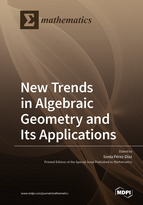New Trends in Algebraic Geometry and Its Applications
A special issue of Mathematics (ISSN 2227-7390). This special issue belongs to the section "Algebra, Geometry and Topology".
Deadline for manuscript submissions: closed (30 September 2021) | Viewed by 16699
Special Issue Editor
Interests: study and analysis of symbolic; numeric and approximate algorithms; applications to the theory of curves and surfaces
Special Issues, Collections and Topics in MDPI journals
Special Issue Information
Dear Colleagues,
Unirational algebraic varieties, in particular curves and surfaces, play an important role in many fields, such as Algebraic Geometry, Computational Geometry, Computer-Aided Design, Computer Graphics, and Geometric Modeling. Consequently, algorithms and results dealing with different algebraic and geometric problems involving these geometric objects are very important.
The Special Issue on “New Trends in Algebraic Geometry and Its Applications” is directed to mathematicians and computer scientists who have a particular interest in algebraic geometry and its applications. In particular, this Special Issue is intended to facilitate communication between researchers who are addressing fundamental algorithmic issues in the treatment of curves and surfaces (from the symbolic and also numeric points of view).
We welcome papers that explore the interplay between geometry, algebra, and numerical computation when designing algorithms for varieties, or provide complexity analysis on the running time of such algorithms.
We are soliciting high-quality original research articles or review articles focused on recent problems concerning algebraic geometry and its applications. Potential topics include, but are not limited to:
- Algorithms for computing the topology of algebraic varieties;
- Algorithms for visualizing algebraic varieties;
- Applications in scientific computing;
- Complexity analysis of algorithms for algebraic varieties;
- Meshing and refinement;
- Computational algebra and applications;
- Computational and algebraic geometry and applications;
- Computer algebra problems solved by means of symbolic-numeric techniques.
Prof. Dr. Sonia Pérez-Díaz
Guest Editor
Manuscript Submission Information
Manuscripts should be submitted online at www.mdpi.com by registering and logging in to this website. Once you are registered, click here to go to the submission form. Manuscripts can be submitted until the deadline. All submissions that pass pre-check are peer-reviewed. Accepted papers will be published continuously in the journal (as soon as accepted) and will be listed together on the special issue website. Research articles, review articles as well as short communications are invited. For planned papers, a title and short abstract (about 100 words) can be sent to the Editorial Office for announcement on this website.
Submitted manuscripts should not have been published previously, nor be under consideration for publication elsewhere (except conference proceedings papers). All manuscripts are thoroughly refereed through a single-blind peer-review process. A guide for authors and other relevant information for submission of manuscripts is available on the Instructions for Authors page. Mathematics is an international peer-reviewed open access semimonthly journal published by MDPI.
Please visit the Instructions for Authors page before submitting a manuscript. The Article Processing Charge (APC) for publication in this open access journal is 2600 CHF (Swiss Francs). Submitted papers should be well formatted and use good English. Authors may use MDPI's English editing service prior to publication or during author revisions.
Keywords
- algebraic geometry
- computer science
- symbolic computation
- geometric computation
- geometry
- algebra






